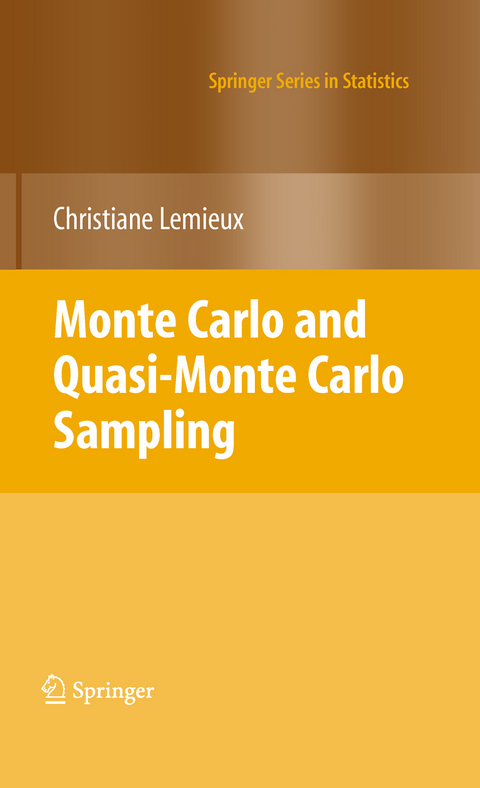
Monte Carlo and Quasi-Monte Carlo Sampling
Seiten
2010
|
Softcover reprint of hardcover 1st ed. 2009
Springer-Verlag New York Inc.
978-1-4419-2676-0 (ISBN)
Springer-Verlag New York Inc.
978-1-4419-2676-0 (ISBN)
Quasi-Monte Carlo methods have become an increasingly popular alternative to Monte Carlo methods over the last two decades. This book presents all of the essential tools for using quasi-Monte Carlo sampling on practical problems, especially in finance.
Quasi–Monte Carlo methods have become an increasingly popular alternative to Monte Carlo methods over the last two decades. Their successful implementation on practical problems, especially in finance, has motivated the development of several new research areas within this field to which practitioners and researchers from various disciplines currently contribute.
This book presents essential tools for using quasi–Monte Carlo sampling in practice. The first part of the book focuses on issues related to Monte Carlo methods—uniform and non-uniform random number generation, variance reduction techniques—but the material is presented to prepare the readers for the next step, which is to replace the random sampling inherent to Monte Carlo by quasi–random sampling. The second part of the book deals with this next step. Several aspects of quasi-Monte Carlo methods are covered, including constructions, randomizations, the use of ANOVA decompositions, and the concept of effective dimension. The third part of the book is devoted to applications in finance and more advanced statistical tools like Markov chain Monte Carlo and sequential Monte Carlo, with a discussion of their quasi–Monte Carlo counterpart.
The prerequisites for reading this book are a basic knowledge of statistics and enough mathematical maturity to follow through the various techniques used throughout the book. This text is aimed at graduate students in statistics, management science, operations research, engineering, and applied mathematics. It should also be useful to practitioners who want to learn more about Monte Carlo and quasi–Monte Carlo methods and researchers interested in an up-to-date guide to these methods.
Quasi–Monte Carlo methods have become an increasingly popular alternative to Monte Carlo methods over the last two decades. Their successful implementation on practical problems, especially in finance, has motivated the development of several new research areas within this field to which practitioners and researchers from various disciplines currently contribute.
This book presents essential tools for using quasi–Monte Carlo sampling in practice. The first part of the book focuses on issues related to Monte Carlo methods—uniform and non-uniform random number generation, variance reduction techniques—but the material is presented to prepare the readers for the next step, which is to replace the random sampling inherent to Monte Carlo by quasi–random sampling. The second part of the book deals with this next step. Several aspects of quasi-Monte Carlo methods are covered, including constructions, randomizations, the use of ANOVA decompositions, and the concept of effective dimension. The third part of the book is devoted to applications in finance and more advanced statistical tools like Markov chain Monte Carlo and sequential Monte Carlo, with a discussion of their quasi–Monte Carlo counterpart.
The prerequisites for reading this book are a basic knowledge of statistics and enough mathematical maturity to follow through the various techniques used throughout the book. This text is aimed at graduate students in statistics, management science, operations research, engineering, and applied mathematics. It should also be useful to practitioners who want to learn more about Monte Carlo and quasi–Monte Carlo methods and researchers interested in an up-to-date guide to these methods.
Christiane Lemieux is an Associate Professor and the Associate Chair for Actuarial Science in the Department of Statistics and Actuarial Science at the University of Waterloo in Canada. She is an Associate of the Society of Actuaries and was the winner of a “Young Researcher Award in Information-Based Complexity” in 2004.
The Monte Carlo Method.- Sampling from Known Distributions.- Pseudorandom Number Generators.- Variance Reduction Techniques.- Quasi–Monte Carlo Constructions.- Using Quasi#x2013;Monte Carlo in Practice.- Financial Applications.- Beyond Numerical Integration.
| Reihe/Serie | Springer Series in Statistics |
|---|---|
| Zusatzinfo | XIV, 373 p. |
| Verlagsort | New York, NY |
| Sprache | englisch |
| Maße | 155 x 235 mm |
| Themenwelt | Mathematik / Informatik ► Mathematik ► Wahrscheinlichkeit / Kombinatorik |
| ISBN-10 | 1-4419-2676-3 / 1441926763 |
| ISBN-13 | 978-1-4419-2676-0 / 9781441926760 |
| Zustand | Neuware |
| Haben Sie eine Frage zum Produkt? |
Mehr entdecken
aus dem Bereich
aus dem Bereich
Eine Einführung in die faszinierende Welt des Zufalls
Buch | Softcover (2024)
Springer Spektrum (Verlag)
CHF 55,95
Buch | Softcover (2024)
Springer Spektrum (Verlag)
CHF 62,95


